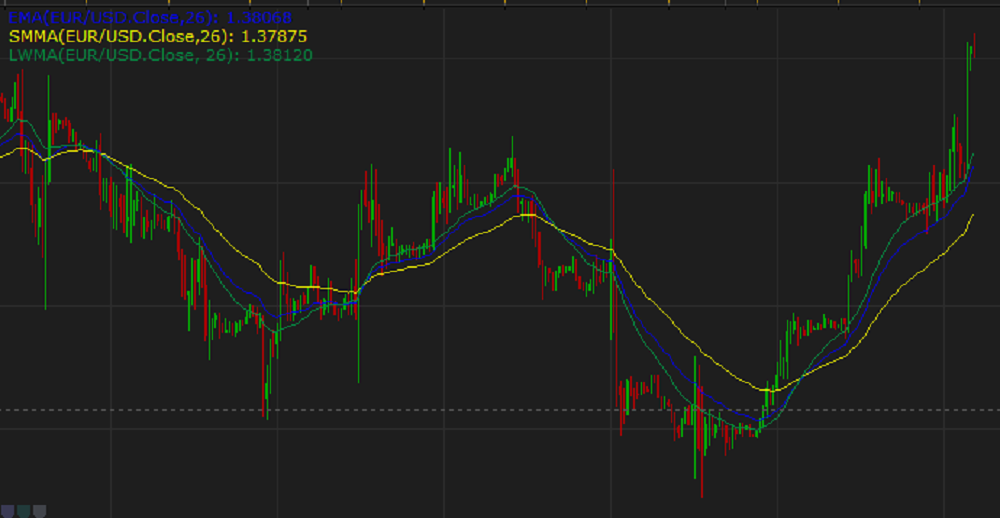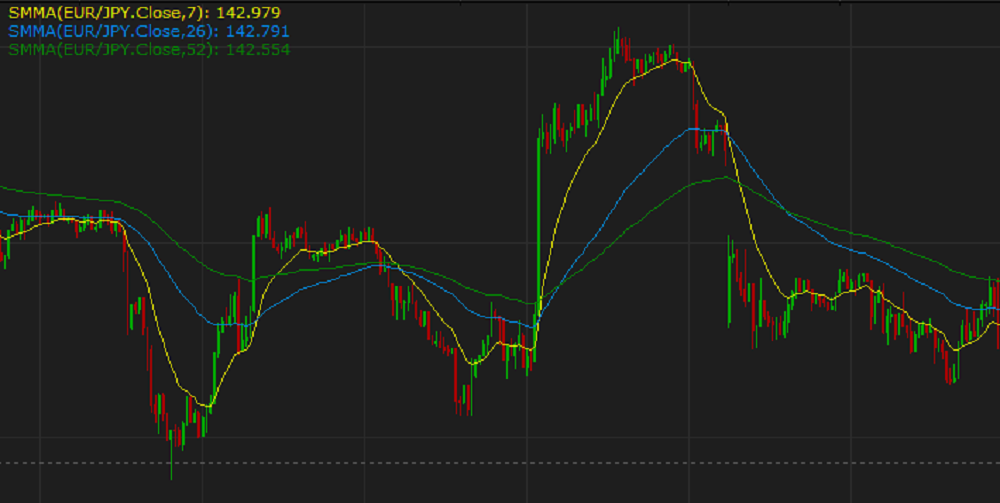SMMA (Smoothed Moving Average)
SMMA (Smoothed Moving Average) is another popular and widely used moving average indicator. It has been developed to smoothen the market noises
and show the market trends more clearly.
As all the other moving average indicators, to achieve the goals, the indicator filters out the market
fluctuations (noises) by averaging the price values of the periods, over which it is calculated. In the process, some extra value (weight) is
added to the average prices, as it is done during calculations of all weighted indicators, such as EMA and LWMA. But during the
SMMA indicator's calculation, it is done in its own way producing slightly different results caused by the fact that the indicator employs all
available historical data for calculation of each and every period's price on the chart, thus, smoothing the market prices to a greater extent
but demonstrating a greater lagging behind the market price changes.
On the following picture, the yellow line of the SMMA indicator of 26
periods looks much flatter due to a greater degree of smoothing but lags behind the market prices more substantially than the lines of the other
indicators of the same number of periods.

By employing the SMMA indicator, a trader gets a crisp picture of the market behavior and can make informed trading decisions. It is good to
use an SMMA indicator in combination with another SMMA indicator of a different period length or other than SMMA indicators.
At the same time, as all the other technical analysis indicators, the SMMA indicator works well only when certain factors influence the market. It works well on stable descending or ascending trends.
Whereas in case of sideway market price movements, the SMMA indicator is useless. A trader should refrain from any trading activity or, if the trading skills and experience permit, use special techniques,
such as pip-hunting.
Because, the SMMA indicator uses the historical data for its calculation, and, as a result, it reveals the market trend that has already developed and does not show the future trend. A trader can only
suppose that the past trend will continue to develop in the same direction for some time in the future and make appropriate trading decisions.
The SMMA indicator is used as a calculation component of some other technical analysis indicators.
To apply an SMMA indicator to a chart, a trader needs to follow the procedure common to all Marketscope indicators. For more information, see the Add Indicator article.
During the procedure, a trader can customize an indicator by specifying its parameters in the Properties dialog box. For more information, see the Change Indicator Properties
article.
The parameters fall into two groups:
- Calculation - the parameters needed to calculate an indicator's prices.
- Style and Appearance - the parameters needed to specify the way an indicator appears on a chart.
The SMMA indicator has only one Calculation parameter - Number of periods. The parameter allows specifying the number of periods,
over which the indicator is to be calculated. The possible values are from 2 through 10,000. The default value is 7. The smaller the
number is, the less market noises the indicator filters, and the faster it reacts to the market price changes. Its line stays closer to the price
bars, thus, following the shorter-term market trends and producing less lagging. The greater the number is, the more market noises the indicator
filters, and the slower it reacts to the price changes. Its line stays more away from the market price bars, thus, following the longer-term market
trends and producing greater lagging behind the market prices. Traders choose the Number of periods parameter's value in accordance with their
trading tasks, strategies, and techniques. The commonly used values are 7, 14, 26, and 52.
On the following picture, you can see how indicators with different Number of periods parameter's values look like on a chart:

The parameter is available on the Parameters tab of the SMMA Properties dialog box under the Calculation heading.
When an SMMA indicator is drawn on a chart, a trader can analyze its behavior and try to predict the beginning of a new market trend or ending
of an old one, in other words, determine trend reversal points that can serve as trading signals similar to those of the MVA indicator.
The SMMA indicator's values are calculated using the following formula:
SMMAi = (Sum - SMMAi-1) / N
where:
SMMAi - is the value of the period being calculated.
Sum - is the sum of the source prices of all the periods, over which the indicator is calculated.
(Sum = Pricei + Pricei-1 + ... + Pricei-N+1)
SMMAi-1 - is the value of the period immediately preceding the period being calculated.
Price - is the source (Close or other) price of any period participating in the calculation.
N - is the number of periods, over which the indicator is calculated.
back

